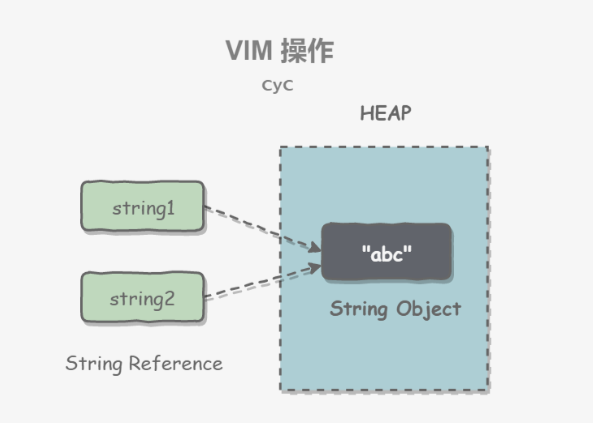String类
String 被声明为 final,因此它不可被继承。(Integer 等包装类也不能被继承)
在 Java 8 中,String 内部使用 char 数组存储数据。
1 | public final class String |
在 Java 9 之后,String 类的实现改用 byte 数组存储字符串,同时使用 coder 来标识使用了哪种编码 。
1 | public final class String |
value 数组被声明为 final,这意味着 value 数组初始化之后就不能再引用其它数组。并且 String 内部没有改变 value 数组的方法,因此可以保证 String 不可变。
不可变的好处
1. 可以缓存hash值
因为 String 的 hash 值经常被使用,例如 String 用做 HashMap 的 key。不可变的特性可以使得 hash 值也不可变,因此只需要进行一次计算。
2. String Pool 的需要
如果一个 String 对象已经被创建过了,那么就会从 String Pool 中取得引用。只有 String 是不可变的,才可能使用 String Pool。

3. 安全性
String 经常作为参数,String 不可变性可以保证参数不可变。例如在作为网络连接参数的情况下如果 String 是可变的,那么在网络连接过程中,String 被改变,改变 String 的那一方以为现在连接的是其它主机,而实际情况却不一定是。
4. 线程安全
String 不可变性天生具备线程安全,可以在多个线程中安全地使用。
Program Creek : Why String is immutable in Java?
String, StringBuffer and StringBuilder
1. 可变性
- String 不可变 如果您尝试更改其值,则会创建另一个对象 。地址改变
- StringBuffer 和 StringBuilder 可变
2. 线程安全
- String 不可变,因此是线程安全的
- StringBuilder 不是线程安全的 1.5之后
- StringBuffer 是线程安全的,内部使用 synchronized 进行同步
StackOverflow : String, StringBuffer, and StringBuilder
StringBuffer和StringBuilder的区别在于,StringBuffer是线程安全的。因此,当应用程序需要在单个线程中运行时,最好使用StringBuilder。StringBuilder比StringBuffer更高效。
3. 使用场景
- 如果你的字符串不会改变,那就使用string类,因为string对象是不可变的。
- 如果您的字符串可以更改(例如:字符串构造中的大量逻辑和操作)并且只能从单个线程访问,则使用StringBuilder就足够了。
- 如果您的字符串可以更改,并且可以从多个线程访问,请使用StringBuffer,因为StringBuffer是同步的,所以具有线程安全性。
4. java.lang.StringBuffer
代表可变的字符序列,可以对字符串内容进行增删。
很多方法与String相同,但StringBuffer是可变长度的 .
StringBuffer是一个容器。
StringBuffer类有三个构造器:
1.StringBuffer() 初始容量为16的字符串缓冲区
2.StringBuffer(int size)构造指定容量的字符串缓冲区
3.StringBuffer(String str)将内容初始化为指定字符串内容
StringBuffer类的常用方法:
StringBuffer append(String s), StringBuffer append(int n) ,
StringBuffer append(Object o) , StringBuffer append(char n),
StringBuffer append(long n), StringBuffer append(boolean n),
StringBuffer insert(int index, String str)
public StringBuffer reverse()
StringBuffer delete(int startIndex, int endIndex)
public char charAt(int n )
public void setCharAt(int n ,char ch)
StringBuffer replace( int startIndex ,int endIndex, String str)
public int indexOf(String str)
public String substring(int start,int end)
public int length()
String Pool
字符串常量池(String Pool)保存着所有字符串字面量(literal strings),这些字面量在编译时期就确定。不仅如此,还可以使用 String 的 intern() 方法在运行过程将字符串添加到 String Pool 中。
当一个字符串调用 intern() 方法时,如果 String Pool 中已经存在一个字符串和该字符串值相等(使用 equals() 方法进行确定),那么就会返回 String Pool 中字符串的引用;否则,就会在 String Pool 中添加一个新的字符串,并返回这个新字符串的引用。
下面示例中,s1 和 s2 采用 new String() 的方式新建了两个不同字符串,而 s3 和 s4 是通过 s1.intern() 方法取得同一个字符串引用。intern() 首先把 s1 引用的字符串放到 String Pool 中,然后返回这个字符串引用。因此 s3 和 s4 引用的是同一个字符串。
1 | String s1 = new String("aaa"); |
如果是采用 “bbb” 这种字面量的形式创建字符串,会自动地将字符串放入 String Pool 中。
1 | String s5 = "bbb"; |
在 Java 7 之前,String Pool 被放在运行时常量池中,它属于永久代。而在 Java 7,String Pool 被移到堆中。这是因为永久代的空间有限,在大量使用字符串的场景下会导致 OutOfMemoryError 错误。
直接使用双引号声明出来的String对象会直接存储在常量池中。
如果不是用双引号声明的String对象,可以使用String提供的intern方法。intern 方法会从字符串常量池中查询当前字符串是否存在,若不存在就会将当前字符串放入常量池中。
new String(“abc”)
使用这种方式一共会创建两个字符串对象(前提是 String Pool 中还没有 "abc" 字符串对象)。
"abc"属于字符串字面量,因此编译时期会在String Pool中创建一个字符串对象,指向这个 “abc” 字符串字面量;- 而使用 new 的方式会在堆中创建一个字符串对象。
创建一个测试类,其 main 方法中使用这种方式来创建字符串对象。
1 | public class NewStringTest { |
使用 javap -verbose 进行反编译,得到以下内容:
1 | // ... |
在 Constant Pool 中,#19 存储这字符串字面量 “abc”,#3 是 String Pool 的字符串对象,它指向 #19 这个字符串字面量。在 main 方法中,0: 行使用 new #2 在堆中创建一个字符串对象,并且使用 ldc #3 将 String Pool 中的字符串对象作为 String 构造函数的参数。
以下是 String 构造函数的源码,可以看到,在将一个字符串对象作为另一个字符串对象的构造函数参数时,并不会完全复制 value 数组内容,而是都会指向同一个 value 数组。
1 | public String(String original) { |
面试题
1 | package string; |
结论:
1.常量与常量的拼接结果在常量池中, 且常量池中不会存在相同的常量
2.只要其中有一个是变量, 结果就在堆中, 会重新new一个对象在堆中。 比如上面的s4,s5,s6
3.如果拼接的结果调用
intern方法,返回值就在常量池中。
下列程序运行的结果:
1 | package string; |
1 | String s1 = "123"; |
下面的输出是什么:
1 | String str = null; |
解释:
1 | private AbstractStringBuilder appendNull() { |
String字符串对象操作
public int length() 返回字符串的长度
public char charAt(int index) 指定下标的字符
public boolean equals(Object anObject)
public int compareTo(String anotherString) 比较
public int indexOf(String s) 指定字符或者字符串的下标 第一次出现
public int indexOf(String s ,int startpoint)
public int lastIndexOf(String s)
public int lastIndexOf(String s ,int startpoint)
public boolean startsWith(String prefix) 是否以指定字符串开始的
public boolean endsWith(String suffix) 是否以指定字符串结束的
public boolean regionMatches(int firstStart,String other,int otherStart ,int length)
String字符串对象修改
public String substring(int startpoint)
public String substring(int start,int end) //子字符串 包头不包尾 (左闭右开)
pubic String replace(char oldChar,char newChar)
public String replaceAll(String old,String new)
public String trim() 去掉字符串首部和尾部的空格
public String concat(String str) 等价于 “ + ”
public boolean contains(CharSequence s) 是否 包含指定的字符串
public String[] split(String regex) 根据给定正则表达式的匹配拆分此字符串。
源码分析
构造字符串
对于String来说:内部创建一个字符数组(JDK8),JDK9之后是一个字节数组
1 | String str1 = new String(); // new char[]{}; |
对于StringBuffer来说:
1 | StringBuffer sb1 = new StringBuffer(); |
1 | // jdk1.8源码: |
1 | sb1.append('a'); // value[0] = 'a'; |
StringBuffer 中的 append + 扩容
1 | public AbstractStringBuilder append(String str) { |
jdk12:
1 |
|
如果添加的数据在底层数组盛不下了,那就需要扩容数组。默认情况下,扩容为原来的2倍+2, 同时将原有的数组中的元素复制到新数组当中。
建议: 在实际开发中应该避免频繁的扩容,推荐使用构造函数:
1 | public StringBuffer(int capacity) { |
指定容量。
同理,StringBuilder底层的append和扩容也是和StringBuffer一样的。
StringBuffer和StringBuilder的额外方法
以StringBuffer为例:
StringBuffer append() ;
StringBuffer delete(int start, int end) ; // 删除指定位置的内容
StringBuffer insert(int offset,, xxx) ; // 在指定位置插入字符串
String replace(int start, int end, String str);
StringBuffer reverse(); 反转字符串
效率测试
1 |
|
在JDK8中测试:(ms)
StringBuffer的执行时间:11
StringBuilder的执行时间:4
String的执行时间:1075
在JDk12:
StringBuffer的执行时间:6
StringBuilder的执行时间:2
String的执行时间:545


